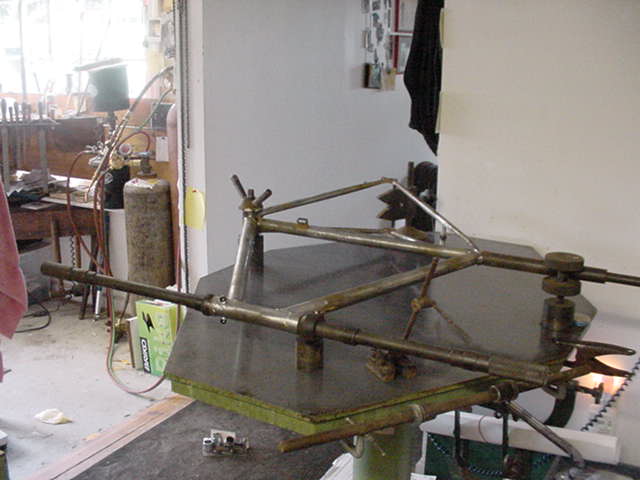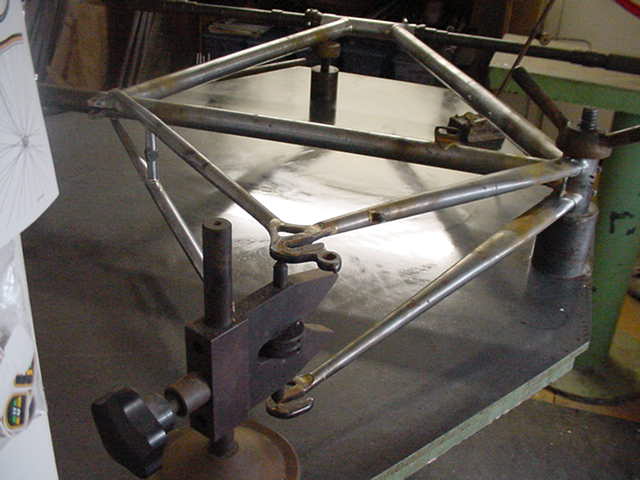
Originally Posted by
Craig Ryan

Richard,
You posted a nice response on the email list once, maybe 4-6 years ago, and I think it's what you are referring to. I'm not sure of the date anymore, but you were replying to MManning and I'm sure there were other emails related to it. I don't think it's been altered except through formatting. This is a nice companion to your recent Tulsa photo series which also has some good description within it. As a note, there is a whole lot of intuition and lots of brain cells between the lines of the words below. A couple of the words may be chopped off, but the intent remains.
Craig
---------------------------------
Richard's sequence
Only after the tube cuts are all made do I drill through all lugs into a ll tube, thus ensuring after all the checks and balances are made in the fixture that the interference fits are as "at rest" within each lug and in as "as assembled into a main triangle" sequence as they can be.
After all parts are drilled and pinned, the pins are more like dowels than replacements for said fixture, but I do use far fewer clamps on the fixture once the parts are pinned, reassembled in the fixture, and fluxed ready to tack, etc. I am a believer that the material is the weak link in the process and one can only hope to use good fixturing, sequencing, and intuition in order to make a straight frame from pipes that carry a margin of error as a matter of course. And that opinion also is tethered to the fact that heat affects metal, particularly when metal is forced against neighboring metal, as is the case when a frame is assembled. It's necessary to find a method that works for you and you alone based on the tooling available and your skill set to date.
Most joints have two pins in each pipe as a matter of course. On my frames, sometimes I get ambivalent and use one per pipe (especially if I am low on pins and or breaking drill bits) but nearly all the dt to bb sockets have the three pins. iow, I know what is yielded in my own process, so two pins vs three won't change the results I have come to realize.
At the "let's go" time, the entire main triangle is cleaned, fluxed, and checked in the hydra fixture. If I am still happy with what is in front of me, I drive the pins in so they "wedge", and then I remove this unit and put it on my M+L table. I then lightly tack the seat tube to the bb at a perfect reading. When cool, I take the main triangle and put it BACK into the hydra fixture and use only the head tube cones to center the front to the back (head tube to seat tube). Then, I tack the front lips of the two head lugs, and also the top point on the bottom lug and the back-of-head-lug point on the top lug.
After cooling, I return the unit to the M+L table and verify 1) that the seat tube is STILL at "zero" and 2) I use a lightweight head tube check bar to verify that the steering axis is at "zero" too. if the steering axis is askew, even though the head lugs are tacked, I can 'tweak" the measurement because the front triangle assembly can STILL move within 1) the seat lug and 2) the down tube port of the bb shell. No matter, once the steering axis is at "zero", I then tack one area of theseat lug whilst the frame is still on board the M+L table because I do not want to manhandle it and change any setting. With this all done, the ONLY non-tacked area is the down tube to bb shell port. That comes later.
I then 1) braze up the head lugs and let cool, 2) wash off flux, and 3) check linearity again. If something in the steering axis er, drifted, I can still correct for a thou or three by turning the lighter head tube rod checker within the head tube, and the correction comes because the down tube still has area in which to rotate within the bb shell port. if all is then copasetic, I braze the seat lug. If all stays copasetic, I place the unit back on the M+L table and tack the down tube to the bb shell so that the steering axis is directly in front of the biomechanical axis (i.e., the seat tube). Then I braze up the bb shell in one fell swoop.
Note to self - up until a year ago, my sequence was different; I used to attack the bb shell assembly first and then would continue on to the head lugs and then on to the seat lug. I cannot recall why I considered changing, but did, and I am content with the net results. Oh, and yes - at the end of all the pre-checks that precede any tacking to begin with, the fixture points, especially the clamps, are in their loosest state. The fit-ups and the pins do the job at that point. I should have noted this earlier.
4) the gap in the chain stay to bb socket is an illusion in these pics. I fear that I shot the image(s) when the parts were pinned but the seat stays were not yet pinned to the seat lug. had this been the case, that "gap" would have closed as the rear triangle's interior angle would become more acute.
I hope the text helps.
e-RICHIE
------------------------------


 Likes:
Likes: 


 Reply With Quote
Reply With Quote





Bookmarks